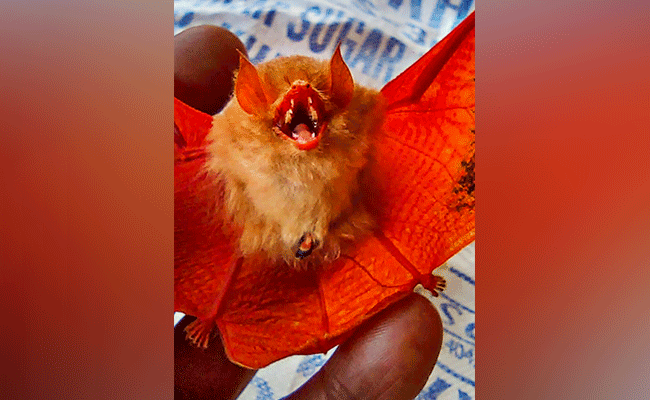Jagdalpur (PTI): A rare orange coloured bat, which is a "near threatened" species, has been spotted in Chhattisgarh's Kanger Valley National Park, officials said on Wednesday.
The animal, also known as 'painted bat' and characterised by bright orange and black wings, was sighted at a banana farm in Parali Bodal village of the park on Monday, the national park's director, Dhammshil Ganvir, told PTI.
The bright orange-coloured bat was seen for the third time in the last few years in the Kanger Valley National Park located in Bastar district, he said, adding that earlier it was seen in 2020 and 2022.
The national park is famous for its limestone caves which also provide a suitable habitat for the bats, as per experts.
The painted bat, whose scientific name is 'Kerivoula picta', is a "near threatened" species and commonly seen in Bangladesh, Myanmar, Cambodia, China, India, Indonesia, Malaysia, Nepal, Sri Lanka, Thailand and Vietnam, Ganvir said.
"The painted bats are aerial hawkers, which means they catch insects while flying in the air. It is often observed at the time of maize harvest," Ganvir said.
A survey will soon be conducted to ascertain varieties of bats found in the national park, he said.
The park, spread over an area about 200 sq km, is rich in biodiversity and sightings of some of the rare species of fauna were reported multiple times in the past, Ganvir said.
"In India, this bat has so far been seen in the Western Ghats, Kerala, Maharashtra, Odisha and the Kanger Valley in Chhattisgarh," he said.
These bats prefer to live in dry areas and dense moist forests. For roosting, they prefer to take shelter under banana leaves, the official said.
"We have decided to launch a survey to ascertain the varieties of bats found in the park and take conservation measures accordingly," he added.
Bastar-based ornithologist Ravi Naidu told PTI that the painted bat was first found in the Kanger Valley National Park in an injured condition in November 2020.
"We rescued it and later released it into its habitat," said the expert, who is currently working for the Bombay Natural History Society (BNHS) on a project.
Naidu's said his research paper on the painted bat in Kanger Valley was published in the Journal of the Wildlife Preservation Society 'Cheetal' in 2020.
The expert claimed he has spotted 26 species of bats in Chhattisgarh and said his research paper on it will be published soon.
The painted bat is characterised by bright orange and black wings, dense orange fur on the back and warm buff below. Their hairy face has no ornamentation or nose leaf. Their ears are large and funnel-shaped with transparent tragus, he said.
In India, there are about 131 species of bats and 31 of them are found in central parts of the country. The Kanger Valley National Park is famous for its limestone caves which also provide a suitable habitat for the bats, Naidu said.
During a faunistic diversity survey earlier, 20 species of bats were reported from Bastar district, mostly in the Kanger Valley, he added.
Let the Truth be known. If you read VB and like VB, please be a VB Supporter and Help us deliver the Truth to one and all.
Thiruvananthapuram (PTI): Buoyed by the strong performance of the Congress-led UDF in the local body polls, KPCC president Sunny Joseph said on Saturday that the front's results indicated the people had rejected the LDF government.
According to early trends, the UDF was leading in more grama panchayats, block panchayats, municipalities and corporations than the LDF.
The local body polls were held in two phases in the state earlier this week.
ALSO READ: Cong candidate who moved Kerala HC for name reinstatement in voter list, wins
Speaking to reporters here, Joseph said the people of Kerala had extended their support to the UDF.
"We could expose the LDF government’s anti-people stance and the people understood it. The LDF’s fake propaganda was rejected by the people. The UDF is moving towards a historic victory," he said.
He said a united effort, proper preparations, good candidate selection and hard work had resulted in the Congress and the UDF’s victory in the elections.
Asked about the prospects in the Thiruvananthapuram Corporation, Joseph said the party was studying the matter and would comment later.
LDF convenor T P Ramakrishnan said the results would be closely examined.
According to him, the government had done everything possible for the people.
"Why such a verdict happened will be examined at the micro level. People’s opinion will be considered and further steps will be taken," he said.
He added that decisions would be taken after analysing the results. "If any corrective measures are required, we will initiate them and move forward," he said.
AICC leader K C Venugopal said the results showed that people had begun ousting those who, he alleged, were responsible for the loss of gold at Lord Ayyappa’s temple.
"This trend will continue in the Assembly elections as well. It is an indication that the people are ready to bring down the LDF government," he said.
Venugopal said the UDF had registered victories even in CPI(M) and LDF strongholds.
"I congratulate all UDF workers for their hard work. Congress workers and leaders worked unitedly," he said.
Referring to remarks made by Chief Minister Pinarayi Vijayan against the Congress on polling day, Venugopal said the voters had responded through the verdict.
"I do not know whether the chief minister understands that the people are against him. Otherwise, he does not know the sentiment of the people. The state government cannot move an inch further," he said.
He said the results indicated a strong comeback for the UDF in Kerala.
Asked whether the Sabarimala gold loss issue had affected the LDF in the local polls, Venugopal said the CM and the CPI(M) state secretary did not take the issue seriously.
"We took a strong stand on the matter. The BJP played a foul game in it," he alleged.
On the BJP's role in the local body elections, Venugopal alleged that the party operated with the CPI(M) 's tacit support.
"The CPI(M) supported the central government on issues such as PM-SHRI, labour codes and corruption in national highway construction. The CPI(M) is facing ideological decline, and the state government’s policies are against the party’s own decisions," he said.
Meanwhile, LDF ally Kerala Congress (M) leader Jose K Mani said the party could not win all the wards it had expected in the elections.
He congratulated winners from all parties and said the party would closely examine the losses and identify shortcomings. "Later, we will take corrective measures," he added.
Senior Congress leader and MP Rajmohan Unnithan said the trends in the local body elections indicated that the UDF would return to power in the 2026 Assembly elections.
"We will win 111 seats as in 1977 and return to power in 2026. The anti-government sentiment of the people is reflected in the elections," he said.
Unnithan said the people were disturbed and unhappy with the present government.
"The trend indicates the end of the LDF government," he added.
CPI(M) MLA M M Mani said the people had shown ingratitude towards the LDF despite benefiting from welfare schemes.
"After receiving all welfare schemes and living comfortably, people voted against us due to some temporary sentiments. Is that not ingratitude," he asked.
Mani said no such welfare initiatives had taken place in Kerala earlier.
"People are receiving pensions and have enough to eat. Even after getting all this, they voted against us. This is what can be called ingratitude," he said.
Muslim League state president Panakkad Sayyid Sadiq Ali Shihab Thangal said the results were beyond expectations.
"The outcome points towards the Secretariat in Thiruvananthapuram, indicating that a change of government is imminent. We are going to win the Assembly election," he said.





